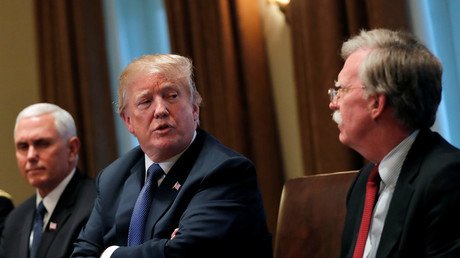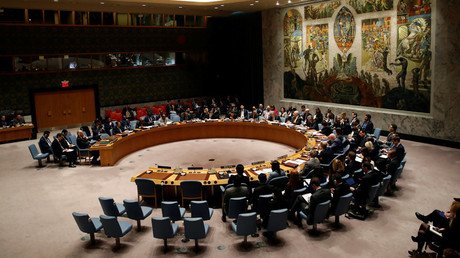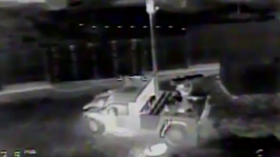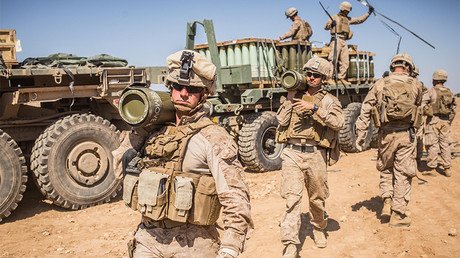Biased media coverage of ‘chemical attack’ in Syria could provoke a dangerous new war
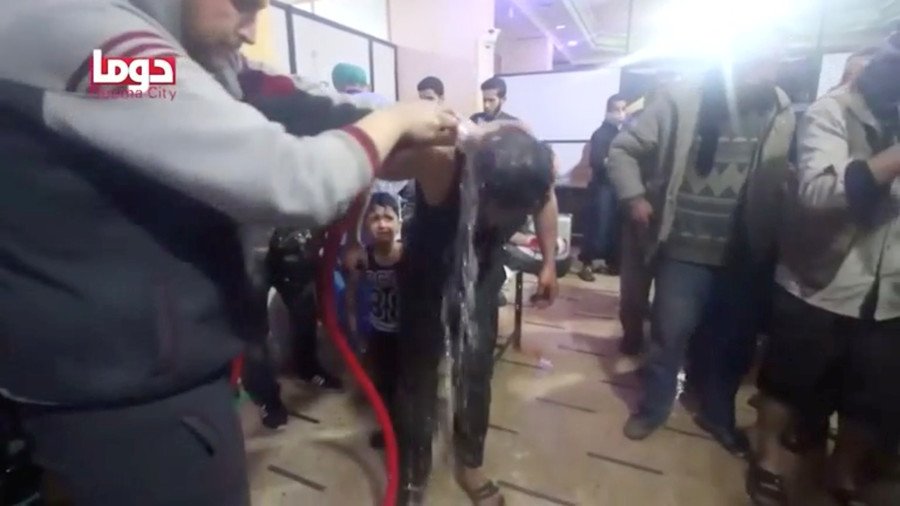
By jumping to conclusions about the alleged chemical weapons attack in Syria, Donald Trump’s war cabinet and their media cheerleaders are recklessly pushing us closer to a military confrontation between Russia and the US.
With his new national security adviser John Bolton standing behind him, US President Trump announced on Monday that “everybody” – apparently meaning Syria and Russia – “will pay a price” for the alleged chemical attack in Douma, a suburb of Damascus under the control of Jaysh al Islam insurgents, and that his generals were devising a military response. Trump has also said that he holds Russia responsible for the still unverified attack, signaling an escalation between Russia and the US, a dangerous prospect that seems to be lost on an unquestioning US media that is captivated by anti-Russia hysteria.
But as Trump rushes to punish Syria, the media is ignoring and depriving the public of some crucial details leading up to the alleged attack, details that raise serious questions about who’s responsible.
Suspicious timing
The Syrian government is in a stronger position than it has been since the war began and has absolutely nothing to gain from launching a chemical weapons attack. This alone should cause some serious skepticism, especially considering the chronology of events leading up to the alleged attack.
Douma is a city in Eastern Ghouta that is under the control of Jaysh al Islam, a Saudi-backed jihadist group that seeks to replace the Syrian government with an Islamic state.
Jaysh al Islam is extremely sectarian and just as nasty in its rhetoric, tactics and goals as the notorious terrorist group Islamic State (IS, formerly ISIS/ISIL). Jaysh al Islam’s founder, the late Zahran Alloush, had openly called for the ethnic cleansing of religious minorities from Damascus. The group also engages in public executions and has publicly bragged about parading caged civilian women from the minority Alawite sect in the streets as human shields. Those caged minorities were among hundreds of Syrian civilians and soldiers held hostage by the group for years in Douma. As many have pointed out, by using chemical weapons the government would be risking the safety of those hostages, which makes no strategic sense, considering the intense negotiations between the government and Jaysh al Islam over their release.
NOTE: Damascus has been desperatly trying for over three years to release the Adra abducted women & children from #Douma. Why would the State use CW now risking the possible death of those hostages when they were so very close to an outright military victory?
— EHSANI2 (@EHSANI22) April 9, 2018
The recent round of arduous negotiations between Jaysh al Islam and the Syrian government coincided with a months-long battle to rout the militants from Eastern Ghouta. The Syrian government is well on its way to victory, with the remaining militants surrounded by the Syrian army, which has retaken 90 percent of Eastern Ghouta.
Provoking intervention
Most recently, Jaysh al Islam was offered a deal by the Russians to give up their fight and, in exchange, those of the militants who wished to stay could become a local security force in Douma. While the Syrian government has allowed other militant groups to evacuate to northern Syria, the same scenario is difficult to implement for Jaysh al Islam, according to sources involved in the negotiations, because the Turks and the Al-Qaeda militant groups that dominate Idlib do not get along with Jaysh al Islam. Their presence in northern Syria would almost certainly start a war between the various sides. Furthermore, the Syrian government’s shelters in Damascus for the internally displaced are overflowing. They cannot handle the pressure of having to care for more internally displaced civilians, so the government prefers to keep civilians in Douma rather than to evacuate them, which has been a part of the negotiations.
However, the negotiations fell apart after Jaysh al Islam rejected the deal, partly because they wanted to hold on to their heavy weapons. The standoff escalated as militants launched missiles at Damascus, including projectiles that, according to an internal UN advisory to staff in the area, contained explosive fragments that resemble cluster bombs.
That led to the Syrian government’s intense bombardment of Douma over the weekend, an attempt to force the group to surrender. In the midst of the offensive, the authorities in Douma claimed the government had attacked the area with chemical weapons. This has become a pattern among insurgents in Syria: whenever they are about to be defeated, claims of chemical attacks resurface. It is possible that such claims are meant to provoke intervention from the international community, as intervention is the only thing that can save them. They also have a history of provoking harsh reactions from the government to justify making concessions.
Another crucial fact that has been left out of the western media coverage of this alleged attack is that the Syrian army discovered a chemical weapons facility that was under insurgent control in an area of Eastern Ghouta recently recaptured by the government. This means that the insurgents are capable of producing chemical weapons and, therefore, should not be ruled out as potential culprits, should the chemical weapons attack be verified.
The Russian government also warned in recent weeks that the militants were planning to stage a chemical weapons attack to spur outside intervention. This was dismissed by the western press at the time as unserious and is now being ignored for the most part, though some have gone so far as to suggest, with zero evidence, that the Russian warning was all a conspiracy to later blame the militants for the attack.
Interesting that a week ago, Moscow was warning that rebels would use gas in Syria as “a provocation.” Almost like they knew what the Assad regime was about to do and were sowing disinformation ahead of time.
— Julia Ioffe (@juliaioffe) April 8, 2018
Who benefits? The war hawks!
The other beneficiaries of the alleged chemical attack are US war hawks and their media cheerleaders who had a meltdown last week after Trump announced his desire to pull some 2,000 US troops out of Syria.
Aside from the fact that these US forces are illegally occupying Syrian territory and have failed to receive authorization from congress to do so, the usual chorus of warmongers has capitalized on the alleged chemical weapons attack to insist that the US stay in Syria indefinitely.
For example, Republican Senator John McCain, who has long advocated overthrowing the Syrian government and has rubbed elbows with US-backed jihadist proxies that wreaked havoc across the country, claimed that Trump’s announcement about pulling out US troops “emboldened” Syrian president Bashar Assad to launch the chemical weapons attack.
American hypocrisy
Furthermore, it’s important to remember that the chemical attack has only been alleged. There has yet to be a proper and independent investigation to determine whether chemical weapons were used and, if they were, by whom.
The US has demanded the United Nations probe the alleged chemical weapons attack, though, given Trump’s stance on a possible military strike, American officials are clearly uninterested in waiting for the results of such a probe. Ironically, just days earlier the US blocked a call at the UN Security Council for the second week in a row to launch an independent probe into Israel’s massacre of unarmed protesters in Gaza.
Israel, meanwhile, bombed Syria’s T4 airbase, which has been controlled by the Russian military since 2015. The Israelis claim that they targeted the base to attack Iranians stationed there and that Iranians were among the more than a dozen killed at the base. This was likely an effort by Israel to retaliate for the downing of its fighter jet earlier this year by the Syrian army. It may have also been partially an attempt to capitalize on the attention around the chemical attack and distract from the last two weeks of Israeli army massacres of Palestinian demonstrators at the Gaza border. It’s also plausible that the Israelis attacked Syria on behalf of the US, as Trump’s new national security adviser John Bolton has in the past advocated for Israel to attack American adversaries such as Iran. Whatever the case may be, when it comes to Syria and Palestine, US hypocrisy is on full display.
Sketchy sources
Despite the absence of an independent investigation to confirm a chemical attack, the western press has pushed forward with the narrative that the Syrian government and their Russian allies are 100 percent responsible, so it’s important to interrogate their sources.
The western media’s primary source on the chemical attack is the White Helmets, a rescue group heavily funded by the US and UK governments. Marketed by a top PR firm, the White Helmets openly advocate for regime change while working alongside Salafi Jihadi rebels, including groups linked to al Qaeda, in opposition areas. Some of its members have participated in atrocities on video, a fact almost entirely ignored by western media, which is enamored with the group.
Footage from the White Helmets has almost always portrayed insurgent-held areas in Syria as populated only by children and rescue workers. But the conflict isn’t a war between the Syrian government and civilians. It is a war between the Syrian government and a collection of foreign-backed Salafi-Jihadist groups, who seem to be deliberately hidden from view by the White Helmets and other affiliated organizations.
The thousands of militants that control the area are never anywhere to be seen in the footage, which demonstrates a clear agenda at play. That doesn’t mean the footage or images are necessarily fake, just that they are meant to convey a propagandistic narrative that erases the two-sided nature of the war in Syria.
Western media has unquestioningly circulated footage and images from the alleged attack in Douma that was fed to them by the White Helmets. Last year, following the chemical weapons attack in Khan Sheikhoun, Trump was inspired to bomb Syria by the White Helmets footage that was replayed over and over by the US cable news outlets. Trump is surely basing his current decision on the White Helmets footage airing 24/7 on outlets like CNN as we speak, and these outlets know this. By relying on biased sources once again, the Western press has completely erased the atrocities of the insurgents, many of them backed by the US, while leading us dangerously closer to escalation in Syria that could result, either accidentally or intentionally in a hot war with Russia. How very convenient for the war hawks!
The statements, views and opinions expressed in this column are solely those of the author and do not necessarily represent those of RT.

